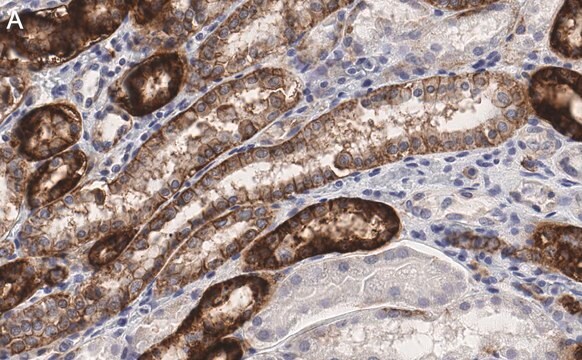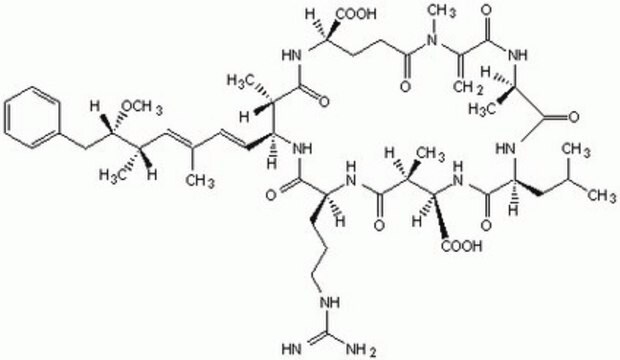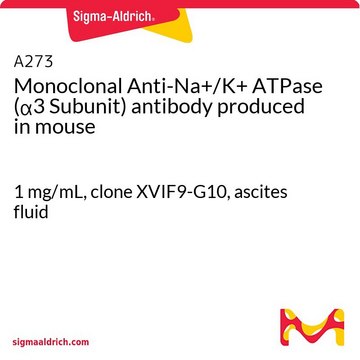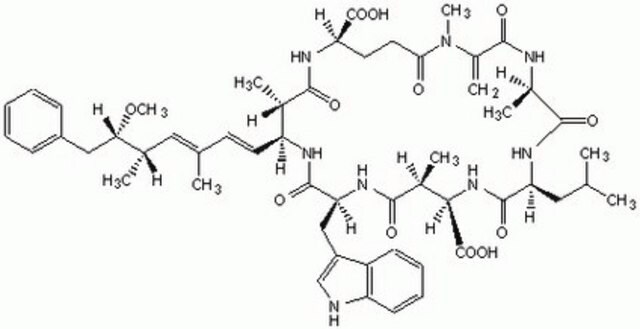A276
Monoclonal Anti-Na+/K+ ATPase (α Subunit) antibody produced in mouse
clone M7-PB-E9, ascites fluid
Synonyme(s) :
Anti-CMT2DD, Anti-HOMGSMR2
About This Item
Produits recommandés
Source biologique
mouse
Niveau de qualité
Conjugué
unconjugated
Forme d'anticorps
ascites fluid
Type de produit anticorps
primary antibodies
Clone
M7-PB-E9, monoclonal
Poids mol.
antigen ~110 kDa
Espèces réactives
canine, chicken, human, sheep, pig, bovine, mouse
Ne doit pas réagir avec
rat, Xenopus
Technique(s)
immunocytochemistry: suitable
immunofluorescence: 1:20
immunohistochemistry (frozen sections): 1:100
immunoprecipitation (IP): suitable
indirect ELISA: suitable
western blot: 1:500-1:5000
Isotype
IgG1
Numéro d'accès UniProt
Conditions d'expédition
dry ice
Température de stockage
−20°C
Modification post-traductionnelle de la cible
unmodified
Informations sur le gène
human ... ATP1A1(476)
Description générale
Immunogène
Application
Actions biochimiques/physiologiques
The different isoforms of the sodium/potassium ATPase exhibit tissue-specific and developmental patterns of expression. The α 1 and β mRNAs are present in all cell types examined, whereas the α 2 and α 3 mRNAs exhibit a more restricted pattern of cell-specific expression. The α subunit has been found in kidney, brain, heart, and to a lesser extent liver, skeletal and smooth muscle.
Description de la cible
Forme physique
Clause de non-responsabilité
Vous ne trouvez pas le bon produit ?
Essayez notre Outil de sélection de produits.
En option
Code de la classe de stockage
13 - Non Combustible Solids
Classe de danger pour l'eau (WGK)
WGK 1
Point d'éclair (°F)
Not applicable
Point d'éclair (°C)
Not applicable
Équipement de protection individuelle
Eyeshields, Gloves, multi-purpose combination respirator cartridge (US)
Certificats d'analyse (COA)
Recherchez un Certificats d'analyse (COA) en saisissant le numéro de lot du produit. Les numéros de lot figurent sur l'étiquette du produit après les mots "Lot" ou "Batch".
Déjà en possession de ce produit ?
Retrouvez la documentation relative aux produits que vous avez récemment achetés dans la Bibliothèque de documents.
Les clients ont également consulté
Notre équipe de scientifiques dispose d'une expérience dans tous les secteurs de la recherche, notamment en sciences de la vie, science des matériaux, synthèse chimique, chromatographie, analyse et dans de nombreux autres domaines..
Contacter notre Service technique










